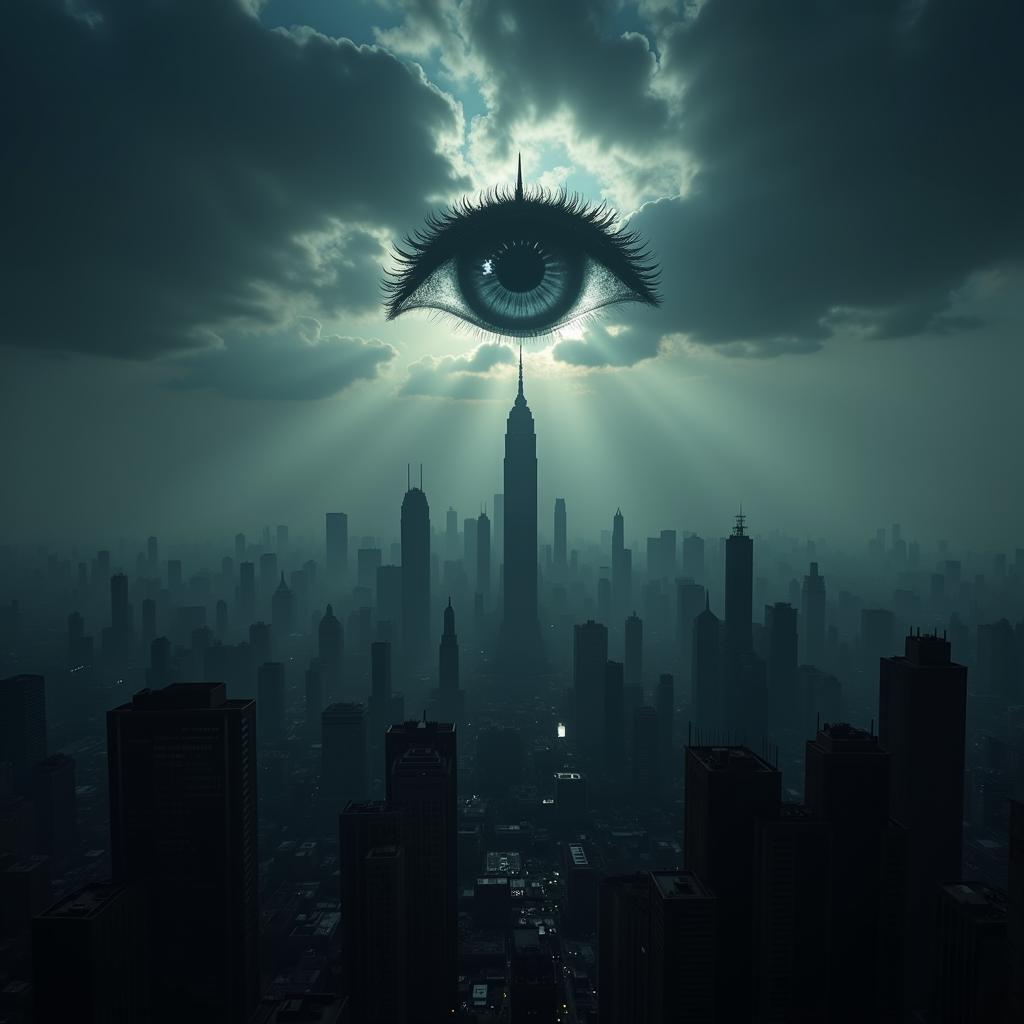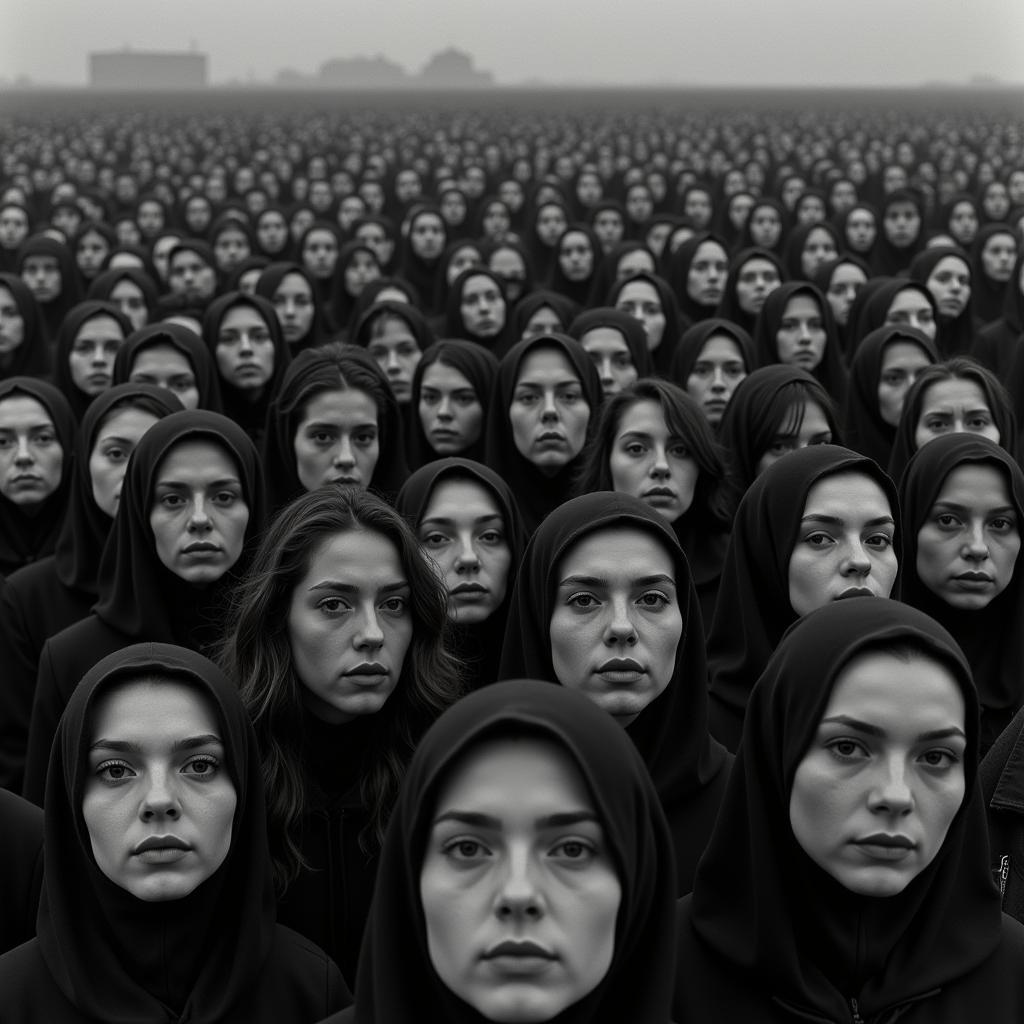The term “dystopian society” often conjures up vivid images: towering skyscrapers casting long shadows over polluted streets, omnipresent surveillance technologies monitoring every move, and a population stripped of individuality and hope. But before any of these chilling details come to life, a dystopia needs a name – something that reflects its oppressive nature, warped values, or the tragic fate that befell it.
 A desolate cityscape shrouded in smog, with towering buildings and a single, watchful eye dominating the skyline.
A desolate cityscape shrouded in smog, with towering buildings and a single, watchful eye dominating the skyline.
Crafting a Name That Speaks Volumes
A dystopian society’s name is more than just a label; it’s a glimpse into the darkness that defines it. It can hint at the controlling forces at play, the environmental devastation, or the societal ills that have taken root. Consider these approaches:
- Reflecting the Regime: “The Imperium,” “The Collective,” or “The Directorate” all suggest a faceless, authoritarian power structure where individual liberties are nonexistent.
- Highlighting Environmental Ruin: Names like “Ashfall,” “The Rustlands,” or “The Drowned Cities” paint a grim picture of ecological collapse and the struggle for survival in a ravaged world.
- Twisting Familiar Concepts: Taking a familiar word or phrase and giving it a sinister twist can be highly effective. “Harmony City” sounds idyllic, until you realize it’s anything but harmonious within its walls.
From Aerie to Zenith: Exploring Dystopian Naming Conventions
Certain patterns often emerge in Dystopian Society Names, each contributing to the overall sense of unease:
- One-Word Wonders: Short, impactful names like “Sector 7,” “Veridia,” or “Panopticon” are stark and memorable, hinting at secrecy or a tightly controlled reality.
- Geographical References: “The Northern Territories,” “The Coastal Enclaves,” or “The Mountain State” can imply isolation, division, and the fragmentation of society.
- Ironic Juxtapositions: “New Eden” or “Utopia Prime” create a jarring contrast between the promised ideal and the grim reality, highlighting the deceptive nature of power.
Beyond the Name: Breathing Life into Your Dystopia
 A crowd of people in uniform, their faces obscured by shadows and their expressions vacant.
A crowd of people in uniform, their faces obscured by shadows and their expressions vacant.
While a compelling name is a crucial first step, it’s the details that truly bring a dystopian society to life:
- What controls are in place? Is it technological surveillance, strict social hierarchies, or the manipulation of information?
- What sparked the descent into dystopia? Was it war, environmental disaster, or the unchecked ambitions of a powerful few?
- What glimmers of hope remain? Even in the darkest of dystopias, there are often individuals or groups who resist, offering a flicker of defiance and the possibility of change.
From Page to Screen: Dystopian Societies That Captivate Us
Think of the chilling effectiveness of names like “Gilead” in The Handmaid’s Tale, “Panem” in The Hunger Games, or “Airstrip One” in Nineteen Eighty-Four. These names are not mere afterthoughts; they are integral to the stories themselves, reflecting the themes, power structures, and social anxieties at the heart of each narrative.
The Power of Words in Shaping Our Understanding
Ultimately, the names we choose for our fictional dystopias can have a powerful impact. They can serve as warnings, social commentaries, or simply compelling backdrops for exploring the complexities of human nature under duress. By carefully crafting names that resonate with meaning and evoke a sense of unease, we can create worlds that linger in the minds of readers and viewers long after the story is over.
Need Help with your Dystopian World?
Contact us for support:
Phone Number: 02043854663
Email: [email protected]
Address: Khu 34, Bac Giang, 260000, Viet Nam.
Our customer service team is available 24/7.